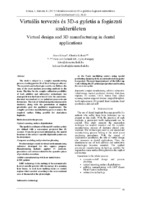Virtual design and 3D manufacturing in dental applications

Megtekintés/
Metaadat
Teljes megjelenítés
Link a dokumentumra való hivatkozáshoz:
Gyűjtemény
- Bánki közlemények [136]
Absztrakt
The study’s subject is a complex manufacturing process creating precise fit of fixed bridge prostheses. The materials and technologies used in our field are the sum of the most modern processing methods in the trade. The idea for the complex utilization possibility of both additive and subtractive technologies has emerged first at the University of Győr. Six years later, the ideal was realized as an optimized process in our laboratory. The role of virtual design has increased in dentistry; along with the penetration of implant prosthetics grew the qualitative requirements. The complex precision manufacturing process makes the required surface fitting possible for dual-phase implants.
Methods used in the process
Optical scanning, surface digitalization
The spatial coordinates of the model’s surface points are defined with a non-contact projected line 3D scanner. From the processed information, the spatial locations of the surface’s specific digitizable points can be determined.
Computer modeling and production planning
Product design is made in virtual environment using softwares developed for this express purpose. Manufacturing includes applied IT methods, procedures and services related to the operative phase of production execution.
Additive manufacturing with laser metal fusion (LMF) printer
LMF technology is the melting of the automatically layered metallic powder with the energy of a scanning laser beam. At each layer melting occurs at certain regions where needed, according to the cross-sectional area of the model at the given height.
Subtractive technology
At the 5-axis machining centers using special positioning clamping-desk, an automatic tool magazine is expected. The most important part of the follow-up work is fixing the 3D printed pre-product and locating the exact zero point.
- Cím és alcím
- Virtual design and 3D manufacturing in dental applications
- Szerző
- Kónya János
- Kulcsár Klaudia
- Megjelenés ideje
- 2018
- Hozzáférés szintje
- Open Access
- Nyelv
- ENG
- Terjedelem
- 38-43. p.
- Tárgyszó
- complex manufacturing, additive, subtractive, virtual design, implant prosthetics, dentistry, dual-phase implants, 3D scanner, CBCT, human bone, optical scanning, implant-supported denture, surgical template, tooth replacement, 3D printed, fixed implants, fixed prosthetics, sint and mill
- Változat
- Kiadói változat
- Egyéb azonosítók
- MTMT: ISSN 2560-2810
- A cikket/könyvrészletet tartalmazó dokumentum címe
- Bánki Közlemények
- A forrás folyóirat éve
- 2018
- A forrás folyóirat évfolyama
- 1
- A forrás folyóirat száma
- 2
- Műfaj
- Tudományos cikk
- Egyetem
- Óbudai Egyetem
